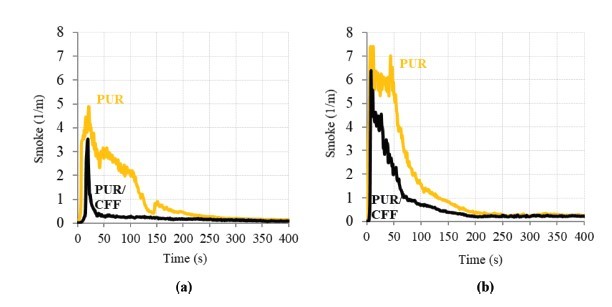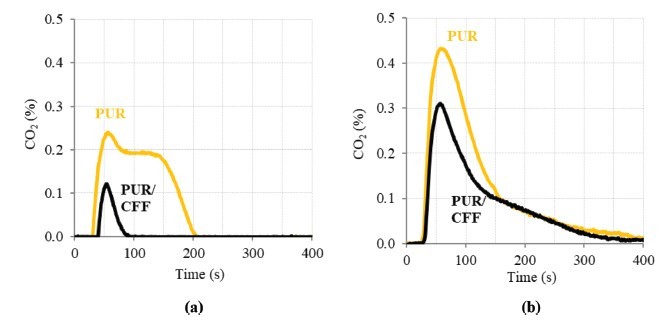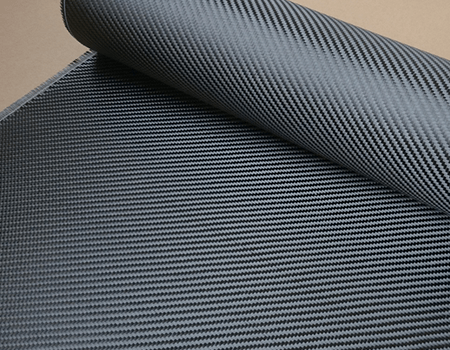Experimental Investigation on Fire Characteristics of Carbon Fiber Reinforced Rigid Polyurethane Foam by Using a Cone Calorimeter
Abstract
In the automotive industry, lightweight construction is an important issue. Therefore, different studies have been done on alternative materials for the interior and the exterior parts. One of these materials is carbon fiber. It has been used together with other materials to produce different automotive parts.
In this concept, it was determined that some of the automotive parts have been produced by using carbon fiber reinforced rigid polyurethane foam to satisfy weight reduction and thermal insulation without interrupting requirements for passenger comfort and safety.
However, it should be pointed out that although the carbon fiber is not flammable material, the rigid polyurethane foam is flammable and can be burned easily. In this study, fire characteristics of carbon fiber reinforced rigid polyurethane foam were investigated by using a cone calorimeter.
In the cone calorimeter experiments, small and medium sized fires were simulated with 15 kW/m
2 and 35 kW/m
2 heat fluxes, respectively. Heat release rate, total heat released, smoke, CO, CO
2 and NO variations of the foams with time were found at 15 kW/m
2 and 35 kW/m
2 heat fluxes.
It was determined that the carbon fiber can significantly enhance the fire resistance of rigid polyurethane foam in small sized fire condition, rather than in medium sized fire condition.
Introduction
In the automotive industry, there are different criteria for commercial competitions between the producers such as fuel consumption, safety, comfort and exhaust emissions. In this respect, lightweight construction become an important issue for vehicles.
Consequently, different studies have been done on alternative composite materials for the exterior and the interior parts of the vehicles [1, 2, 3]. Carbon fiber is an important candidate, which can be used for the composite material productions in the automotive industry.
It has been used together with other materials to produce different automotive parts [4, 5, 6]. In this concept, it was determined that some of the automotive parts have been produced by using carbon fiber reinforced rigid polyurethane foam to satisfy weight reduction and thermal insulation without interrupting requirements for passenger comfort and safety [7, 8, 9].
However, it should be pointed out that although the carbon fiber is not flammable material, the rigid polyurethane foam is flammable and can be burned easily. Therefore, it is required to investigate the fire characteristics of the carbon fiber reinforced composite materials.
There are different tests to investigate the fire characteristics of the polymer materials. Among them, cone calorimeter test is one of the most widely used method to investigate the fire behaviors of the materials [10, 11].
The cone calorimeter test can determine important parameters like heat release rate, total heat released, time to ignition, peak heat release rate, smoke, CO, CO
2 and NO generations. In this study, fire characteristics of neat rigid polyurethane foam (PUR) and carbon fiber fabric reinforced rigid polyurethane foam (PUR/CFF) were investigated with cone calorimeter tests.
The fire characteristics of the foams, which are heat release rate, total heat released, ignition time, smoke, CO, CO
2 and NO generations, were evaluated and compared each other.
Materials and Methods
Materials
The raw materials of the rigid polyurethane foam, which are isocyanate (PMDI 92140), and polyol (Elastopor H2011/4) were purchased from TEKPOL (Technical
Polyurethane Ltd-Turkey). Carbon fiber fabric (CFF) was kindly supplied from Spinteks (Turkey).
Sample Production
The neat rigid polyurethane foam (PUR) was produced in a batch process. The polyol and the isocyanate were stirred with a mechanical stirrer at 3000 min-1 for 12 s and then the mixture was poured into the aluminum mold that was put under the pre-heated press to keep the temperature at 40 ± 2°C for 30 min.
The foams were kept in the laboratory conditions for 24 hours to complete curing process after removing the foams from the mold. The foams were put into the special conditioning device at the temperature 23 ± 1°C and relative humidity 50% ± 3 for 48 hours before the cone calorimeter tests.
Similar procedure was applied to produce the rigid polyurethane foam covered with carbon fiber fabric (PUR/CFF). But the carbon fiber fabric was placed at the bottom of the mold and under the cover of the mold.
Cone Calorimeter Burning Test
The cone calorimeter apparatus shown in Fig. 1 was used to investigate the fire behaviors of PUR and PUR/CFF samples. The cone calorimeter was manufactured according to ASTM E-1354 [12] and ISO 5660 [13] standards. The samples were cut into 100 x 100 x 50 mm, wrapped in 0.04 mm thick aluminum foil, and replaced in the sample holder of the calorimeter. The samples were horizontally exposed to the heat fluxes of 15 kW/m
2 and 35 kW/m
2, which simulate the small and the medium sized fire scenarios, respectively. Temperatures, mass loss, smoke and CO, CO
2 and NO generations were recorded with the special software simultaneously in 1 s increment. Time to ignition (TTI), heat release rate (HRR), total heat released (THR), and peak heat release rate (PHRR) which are important parameters used to compare the fire resistance of different materials were determined.

Figure 1. Pictures of the cone calorimeter and the burning of a sample
Results and Discussion
PUR and PUR/CFF foams were tested in the cone calorimeter at different heat fluxes, namely 15 kW/m
2 and 35 kW/m
2. HRR values of PUR and PUR/CFF foams are shown in Fig. 2. It is obviously seen that CFF reinforcement resulted in approximately 10 s delay of TTI and significantly reduced HRR values of the rigid polyurethane foam at the heat flux of 15 kW/m
2. PHRR values of PUR and PUR/CFF were approximately 95 kW/m
2 and 50 kW/m
2, respectively. However, CFF reinforcement did not significantly affect the ignition behavior of the foam and PHRR values of PUR and PUR/CFF were approximately 146 kW/m
2 and 112 kW/m
2 at the heat flux of 35 kW/m
2, respectively.

Figure 2. HRR of PUR and PUR/CFF at (a) 15 kW/m2 and (b) 35 kW/m2 heat fluxes
Figure 3 shows THR values of PUR and PUR/CFF at two different heat fluxes. While THR of PUR was approximately 11.2 MJ/m
2 at the heat flux of 15 kW/m
2, CFF reinforcement reduced THR value to 1.5 kW/m
2. In other words, there was approximately 87% reduction in THR with CFF. However, when the heat flux exposed to the foams was increased to 35 kW/m
2, THR values of PUR and PUR/CFF were approximately 15.1 MJ/m
2 and 11.9 MJ/m
2 in the burning time of 400 s, this means that the reduction in THR was only 21% in this condition. Figures 4 and 5 show the pictures of PUR and PUR/CFF after cone calorimeter tests at the heat fluxes of 15 and 35 kW/m
2
 Figure 3. THR of PUR and PUR/CFF at (a) 15 kW/m2 and (b) 35 kW/m2 heat fluxes
Figure 3. THR of PUR and PUR/CFF at (a) 15 kW/m2 and (b) 35 kW/m2 heat fluxes

Figure 4. Pictures of PUR after cone calorimeter tests at (a) 15 kW/m2 and (b) 35 kW/m2 heat fluxes

Figure 5. Pictures of PUR/CFF after cone calorimeter tests at (a) 15 kW/m2 and (b) 35 kW/m2 heat fluxes
The other important issues are smoke and CO generations during burning of rigid polyurethane foams. Because, they are the major cause of poisoning during fires. Figures 6 and 7 show smoke and CO generations of PUR and PUR/CFF foams, respectively. It can be clearly seen from Figures 6 and 7, CFF reinforcement decreased the smoke and CO generations. However, CFF was more effective at the heat flux of 15 kW/m
2. Meanwhile, it should be pointed out that CO generations of PUR and PUR/CFF still continued after 200 s at the heat flux of 35 kW/m
2. Although the flame was not appeared at time of 400 s, there was some CO generations implying the smoldering combustion of the rigid polyurethane foams.

Figure 6. Smoke Generations of PUR and PUR/CFF at (a) 15 kW/m2 and (b) 35 kW/m2 heat fluxes

Figure 7. CO Generations of PUR and PUR/CFF at (a) 15 kW/m2 and (b) 35 kW/m2 heat fluxes
CO
2generations of the foams are shown in Fig. 8. The CO
2 variations were very similar to HRR as it is expected. Because CO
2 generation is related to the amount of the burning materials. In addition, Fig. 9 shows NO generations of the foams. NO is another cause of poisoning during fires. CFF also decreased NO generation of the rigid polyurethane foam, especially at small sized fire condition.

Figure 8. CO2 Generations of PUR and PUR/CFF at (a) 15 kW/m2 and (b) 35 kW/m2 heat fluxes

Figure 9. NO Generations of PUR and PUR/CFF at (a) 15 kW/m2 and (b) 35 kW/m2 heat fluxes
Concluding Remarks
In this study, fire behaviors of neat and carbon fiber fabric reinforced rigid polyurethane foam materials were investigated with a cone calorimeter running at different heat fluxes, namely 15 and 35 kW/m
2, which simulate the small, and the medium sized fire conditions, respectively. The heat release rate, the total heat released, smoke, CO, CO
2 and NO variations of the foams with time were determined and compared each other. It was determined that although the carbon fiber fabric can significantly enhance the fire resistance of rigid polyurethane foam in small sized fire conditions, the beneficial effects of CFF decrease in the medium sized fire conditions.
Acknowledgements
The authors would like to thank Pamukkale University Scientific Research Council (BAP) and TUBITAK (The Scientific and Technological Research Council of Turkey for supporting this study.
 Fatih Demiryuğuran
Pamukkale University
Research Assistant
Fatih Demiryuğuran
Pamukkale University
Research Assistant
 Prof. Dr. Nazım Usta
Pamukkale University
Mechanical Engineering Department
Prof. Dr. Nazım Usta
Pamukkale University
Mechanical Engineering Department
Fiber Veil, Journal of Aerospace Technology And Management, 9, 2, 222-231, 2017.
[7] V. Yakushin, U. Stirna, L. Bel’kova, L. Deme, I. Sevastyanova. Properties of Rigid Polyurethane Foams Filled With Milled Carbon Fibers, Mechanics of Composite Materials, 46, 6, 679-688, 2011.
[8] B. Dahlke, H. Larbig, H. D. Scherzer, R. Poltrock. Natural Fiber Reinforced Foams Based on Renewable Resources for Automotive Interior Applications, Journal of Cellular Plastics, 34, 4, 361-379, 1998.
[9] M.C. Silva, J. A. Takahashi, D. Chaussy, M. N. Belgacem, G. G. Sil, Composites of rigid polyurethane foam and cellulose fiber residue, Journal of Applied Polymer Science, 117, 6, 3665–3672, 2010.
[10] M. Checchin, C. Cecchini, B. Cellarosi, F.O. Sam. Use of cone calorimeter for evaluating fire performances of polyurethane foams. Polymer Degradation and Stability, 64, 3, 573-576, 1999
[11] N. Usta. Investigation of fire behavior of rigid polyurethane foams containing fly ash and intumescent flame retardant by using a cone calorimeter, Journal of Applied Polymer Science, 124, 4, 3372-3382, 2012.
[12] ASTM E1354-14, Standard Test Method for Heat and Visible Smoke Release Rates for Materials and Products Using an Oxygen Consumption Calorimeter, ASTM International, West Conshohocken, PA, U. S. A., 2004.
[13] ISO 5660-1: Reaction to fire tests heat release, smoke production and mass loss rate, part 1: heat release rate (cone calorimeter method), 2002.



 Figure 3. THR of PUR and PUR/CFF at (a) 15 kW/m2 and (b) 35 kW/m2 heat fluxes
Figure 3. THR of PUR and PUR/CFF at (a) 15 kW/m2 and (b) 35 kW/m2 heat fluxes





 Fatih Demiryuğuran
Pamukkale University
Research Assistant
Fatih Demiryuğuran
Pamukkale University
Research Assistant
 Prof. Dr. Nazım Usta
Pamukkale University
Mechanical Engineering Department
Prof. Dr. Nazım Usta
Pamukkale University
Mechanical Engineering Department